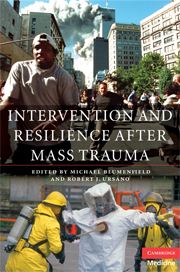Book contents
- Frontmatter
- Contents
- List of contributors
- Foreword by Joseph T. English
- Preface
- 1 Systems, science, and populations: Effective early mental health intervention following mass trauma: the roles of government, clinicians, and communities
- 2 Factors in the development of community resilience to disasters
- 3 Psychological first aid
- 4 Acute stress disorder and early interventions after trauma
- 5 The role of pharmacotherapy in early interventions
- 6 Should culture considerations influence early intervention?
- 7 Resilience is the default: how not to miss it
- 8 Epilog: Early intervention for individuals and communities: planning for the future while meeting present needs
- Index
- References
6 - Should culture considerations influence early intervention?
- Frontmatter
- Contents
- List of contributors
- Foreword by Joseph T. English
- Preface
- 1 Systems, science, and populations: Effective early mental health intervention following mass trauma: the roles of government, clinicians, and communities
- 2 Factors in the development of community resilience to disasters
- 3 Psychological first aid
- 4 Acute stress disorder and early interventions after trauma
- 5 The role of pharmacotherapy in early interventions
- 6 Should culture considerations influence early intervention?
- 7 Resilience is the default: how not to miss it
- 8 Epilog: Early intervention for individuals and communities: planning for the future while meeting present needs
- Index
- References
Summary
Introduction
The question “Should culture considerations influence early intervention?” is not easy to answer because behavior is multidetermined and complex. Thus, this question has multiple different answers. One answer is “Of course culture considerations should influence early intervention.” Clearly, a therapist who only speaks English attempting to effect an early intervention with individuals or a population that only speaks Spanish is not going to have an efficacious and effective outcome. A different answer is “What difference should culture make if a therapist is doing generic early intervention activities?” If a population is starving to death, what difference does it make if the food they get is not culturally familiar to them as long as they eat? Accordingly, sometimes the answer to the question “Should culture considerations influence early intervention?” is “yes” and sometimes it is “no.” This chapter seeks to clarify that the answer is neither “yes” nor “no” but “both/and.” Unfortunately, there is a real dearth of research on cultural, racial and ethnic issues (US Department of Health and Human Services, 2001), and even less research on generic and culturally specific early intervention strategies. Further, political polarities cloud the issue of cultural relevance, thus there is very little honest direction to guide the field in this regard.
- Type
- Chapter
- Information
- Intervention and Resilience after Mass Trauma , pp. 127 - 148Publisher: Cambridge University PressPrint publication year: 2000



